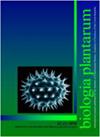Molecular cloning and functional analysis of the thioredoxin gene SikTrxh from Saussurea involucrata
IF 0.9
4区 生物学
Q4 PLANT SCIENCES
引用次数: 0
Abstract
Thioredoxins are oxidoreductases that help to maintain redox homeostasis in plants under abiotic stress. In this study, a new thioredoxin gene, SikTrxh, was cloned from Saussurea involucrata (Kar. & Kir.), a perennial herb that grows in the high alpine mountains of Central Asia. Bioinformatics analysis shows that the full-length cDNA of SikTrxh consisted of 565 bp with a 354-bp open reading frame and encoded a 117 amino acid protein. Using quantitative reverse transcription (RT) PCR, we found that the expression of the SikTrxh gene was induced by salt, cold, and drought stresses, suggesting that this protein played a significant role in plant defense. Subcellular localization confirmed that the protein was localized to the mitochondria. A vector carrying SikTrxh was inserted into tobacco, and successfully modified plants were identified by RT-PCR. Physiological indicators and antioxidant enzyme activities were measured under low temperature, and salt and drought stresses. Our results show that malondialdehyde content and relative electrolyte leakage increased in both wild-type and SikTrxh-overexpressing transgenic plants; however, these increases were significantly higher in the wild-type plants than in the transgenic plants. We also found that photosystem II photoinhibition was lower in the transgenic plants than in the wild-type plants, and that activities of reactive oxygen species-scavenging enzymes were higher in the transgenic plants than in the wild-type plants. We conclude that SikTrxh can reduce toxic effects of reactive oxygen species to protect the plasma membrane, thereby increasing plant resistance to abiotic stresses.雪莲硫氧还蛋白基因SikTrxh的分子克隆及功能分析
硫氧还毒素是一种氧化还原酶,有助于维持植物在非生物胁迫下的氧化还原稳态。本研究从雪莲(Saussurea involucrata)中克隆了一个新的硫氧还蛋白基因SikTrxh。& Kir.),一种生长在中亚高山的多年生草本植物。生物信息学分析表明,SikTrxh全长cDNA全长565 bp,开放阅读框354 bp,编码一个117个氨基酸的蛋白。通过定量反转录(RT) PCR,我们发现SikTrxh基因在盐、冷和干旱胁迫下均可诱导表达,表明该蛋白在植物防御中发挥重要作用。亚细胞定位证实该蛋白定位于线粒体。将携带SikTrxh的载体插入烟草中,并通过RT-PCR成功鉴定了SikTrxh载体对烟草的修饰。测定低温、盐胁迫和干旱胁迫下的生理指标和抗氧化酶活性。结果表明,在野生型和过表达siktrxh的转基因植株中,丙二醛含量和相对电解质泄漏量均有所增加;然而,这些增加在野生型植物中明显高于转基因植物。我们还发现转基因植株的光系统II光抑制低于野生型植株,活性氧清除酶的活性高于野生型植株。我们认为SikTrxh可以减少活性氧的毒性作用,保护质膜,从而提高植物对非生物胁迫的抗性。
本文章由计算机程序翻译,如有差异,请以英文原文为准。
求助全文
约1分钟内获得全文
求助全文
来源期刊

Biologia Plantarum
生物-植物科学
CiteScore
2.80
自引率
0.00%
发文量
28
审稿时长
3.3 months
期刊介绍:
BIOLOGIA PLANTARUM is an international journal for experimental botany. It publishes original scientific papers and brief communications, reviews on specialized topics, and book reviews in plant physiology, plant biochemistry and biophysics, physiological anatomy, ecophysiology, genetics, molecular biology, cell biology, evolution, and pathophysiology. All papers should contribute substantially to the current level of plant science and combine originality with a potential general interest. The journal focuses on model and crop plants, as well as on under-investigated species.
 求助内容:
求助内容: 应助结果提醒方式:
应助结果提醒方式:


